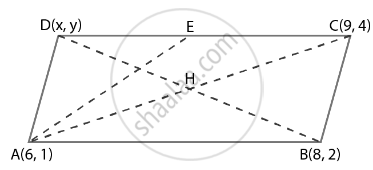Advertisements
Advertisements
Question
A(6, 1), B(8, 2) and C(9, 4) are three vertices of a parallelogram ABCD. If E is the midpoint of DC, find the area of ∆ADE.
Solution
According to the question,
The three vertices of a parallelogram ABCD are A(6, 1), B(8, 2) and C(9, 4)
Let the fourth vertex of parallelogram = (x, y),
We know that, diagonals of a parallelogram bisect each other
Since, mid-point of a line segment joining the points (x1, y1) and (x2, y2) is given by,
`((x_1 + x_2)/2, (y_1 + y_2)/2)`
Mid-point of BD = Mid-point of AC
`((8 + x)/2, (2 + y)/2) = ((6 + 9)/2, (1 + 4)/2)`
`((8 + x)/2, (2 + y)/2) = (15/2, 5/2)`
So, we have,
`(8 + x)/2 = 15/2`
⇒ 8 + x = 15
⇒ x = 7
And
`(2 + y)/2 = 5/2`
⇒ 2 + y = 5
⇒ y = 3
So, fourth vertex of a parallelogram is D(7, 3)
Now,
Mid-point of side
DC = `((7 + 9)/2, (3 + 4)/2)`
E = `(8, 7/2)`
∵ Area of ΔABC with vertices (x1, y1), (x2, y2) and (x3, y3);
= `1/2`[x1(y2 – y3) + x2(y3 – y1) + x3(y1 – y2)]
∴ Area of ΔADE with vertices A(6, 1), D(7, 3) and `"E"(8, 7/2)`
Δ = `1/2[6(3 - 7/2) + 7(7/2 - 1) + 8(1 - 3)]`
= `1/2[6 xx ((-1)/2) + 7(5/2) + 8(-2)]`
= `1/2(35/2 - 19)`
= `1/2((-3)/2)`
= `(-3)/4` but area can’t be negative
Hence, the required area of ΔADE is `3/4` sq.units.
APPEARS IN
RELATED QUESTIONS
Find the area of the triangle ABC with A(1, −4) and mid-points of sides through A being (2, −1) and (0, −1).
If the points A(x, 2), B(−3, −4) and C(7, − 5) are collinear, then the value of x is:
(A) −63
(B) 63
(C) 60
(D) −60
If P(–5, –3), Q(–4, –6), R(2, –3) and S(1, 2) are the vertices of a quadrilateral PQRS, find its area.
If D, E and F are the mid-points of sides BC, CA and AB respectively of a ∆ABC, then using coordinate geometry prove that Area of ∆DEF = `\frac { 1 }{ 4 } "(Area of ∆ABC)"`
Determine the ratio in which the line 2x + y – 4 = 0 divides the line segment joining the points A(2, – 2) and B(3, 7).
Find the area of a triangle whose sides are 9 cm, 12 cm and 15 cm ?
Find the value of x for which points A(x, 2), B(-3, -4) and C(7, -5) are collinear.
The area of the triangle ABC with the vertices A(-5, 7), B(-4, -5) and C(4, 5) is ______.
The points (0, 5), (0, –9) and (3, 6) are collinear.
If the points A(1, 2), O(0, 0) and C(a, b) are collinear, then ______.
